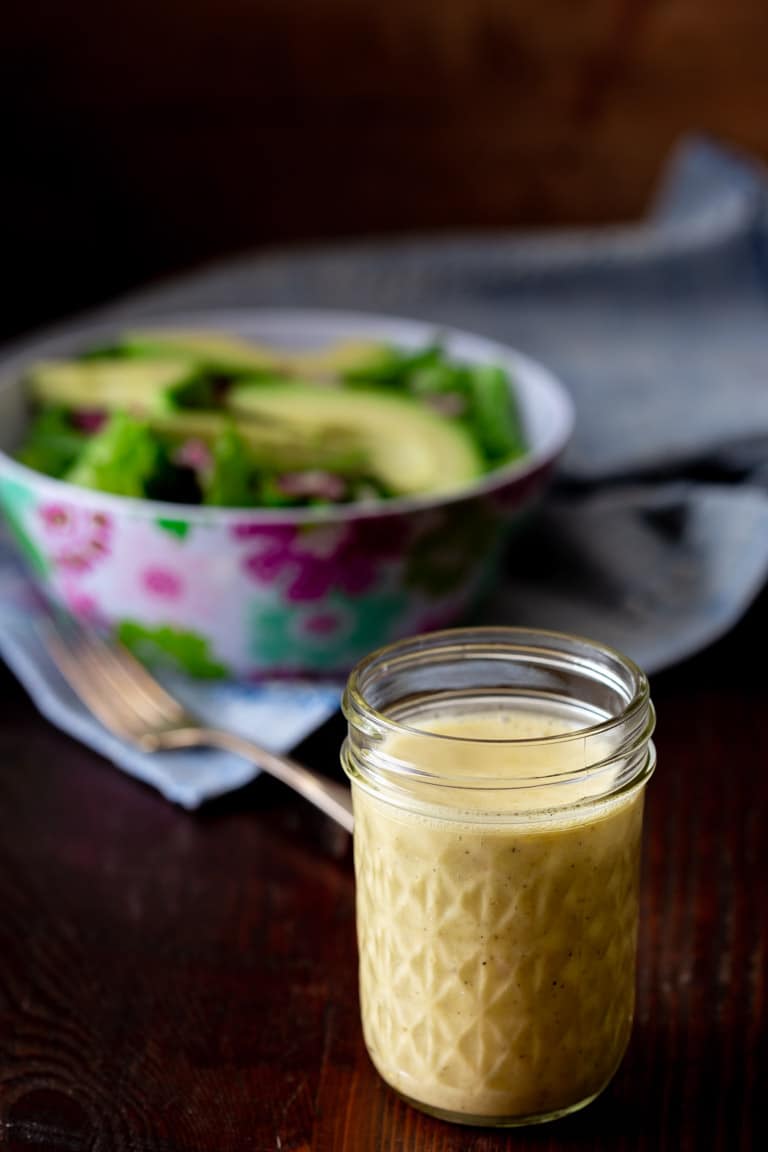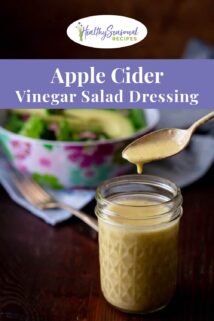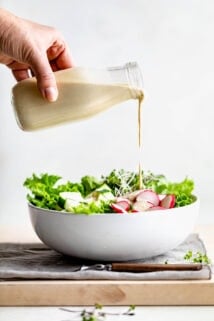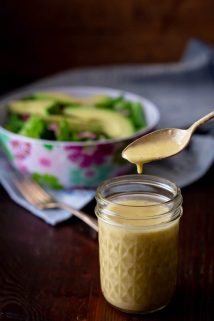Apple Cider Vinegar Salad Dressing
Bye bye bottled dressing! Here is a simple 5 minute recipe for salad dressing using apple cider vinegar. Plus I have a simple list of the elements to make a great homemade salad dressing and vinaigrette from scratch.

I originally shared this Apple Cider Vinegar Salad Dressing on January 29, 2015. I have updated some of the text and re-processed the photographs to share it with you again today. This post contains affiliate links.
Table of contents
- Why We Love Apple Cider Vinaigrette
- Ingredients For Apple Cider Vinaigrette
- How To Make Apple Cider Vinaigrette Dressing
- FAQs and Expert Tips for This Recipe
- Variations To Try
- Can I whisk the dressing instead of blending?
- What Is Apple Cider Vinegar?
- More Healthy Salad Dressings To Check Out:
- Expert Tips for Making Homemade Salad Dressing:
Why We Love Apple Cider Vinaigrette
If I had to choose just one salad dressing to use for the rest of my life, it would be this apple cider vinaigrette. Thankfully I don’t have to choose just one because I happen to LOVE salad dressings of all kinds, and have dozens and dozens of salad dressings here on my site, in my cookbook and beyond! But this apple cider vinegar dressing is my first love when it comes to simple salad dressing.
Recipe Highlights
- Make Ahead Friendly: Keep it in the fridge for up to one week. A zesty apple cider vinaigrette can be kept on hand all week long for a quick way to complete a meal with a simple salad of cleaned greens and chopped veggies.
- Versatile: It pairs with so many seasonal salad combinations! We love it with bold Chopped Winter Salads, fresh garden salads anytime of the year and even with tender spring salad.
- Adaptable: Can be adapted to use your favorite herbs or customized with more or less of the ingredients to suit your palette.
I make this almost weekly! It’s so easy to pull together and I love the flavor combo! I have actually stopped using store-bought dressings!
~Jackie
Ingredients For Apple Cider Vinaigrette

- Shallot: you can sub in garlic or minced onion, or even use a couple pinches of garlic powder if you’re in a hurry.
- Extra Virgin Olive Oil: For great flavor
- Apple Cider Vinegar: look for raw unfiltered apple cider vinegar for great flavor. Read more about the difference here.
- Dijon Mustard: It acts as an emulsifier to hold the vinaigrette in suspension and keeps the oil and vinegar from separating
- Honey: A little honey helps to balance the strong acidity. Another sweetener can be used, or you can omit it if you really like strong sour flavors.
- Salt: To balance the acid in the apple cider vinegar you need a little salt. Make sure to use a half teaspoon of regular table salt, or a full teaspoon of kosher salt. Read more about subbing kosher salt for table salt here.
- Pepper: I always add a bit of black pepper into my dressings, and usually over my salad at the table too! This recipe for apple cider vinegar vinaigrette is no exception!
How To Make Apple Cider Vinaigrette Dressing


- Assemble your ingredients and decide how you’ll be blending the dressing. My step-by-step photos above show me making this with an immersion blender, but you can do this with your mini-prep or a blender too. Or if you don’t have any of those, you can always whisk it by hand.
- Peel and cut the shallot into quarters. Pop that right into the blender or blending jar. Add in the oil, apple cider vinegar, Dijon, honey and salt and pepper.
- Note: if you’re whisking this by hand, you’ll want to wait and gradually whisk the oil in after the other ingredients are combined to emulsify it.
- Puree the vinaigrette until it is smooth. Enjoy tossed with your favorite salad like this Spinach Salad or My Easy Garden Salad to name a couple.

FAQs and Expert Tips for This Recipe
Variations To Try
- Instead of olive oil, use a blend of half olive oil and half neutral cooking oil (such as avocado oil) to make the olive oil taste less pronounced.
- Add chopped fresh herbs like a teaspoon of chives, oregano or tarragon.
- Instead of honey use maple syrup for another variation.
- Increase the oil to 1/2 cup, omit the honey and add another small pinch of salt to make this keto-friendly.
- Chop a small clove of garlic and use in place of the shallot
Can You Make Apple Cider Vinaigrette Ahead?
- Yes absolutely! You can store the homemade dressing in a jar or resealable container for up to a week in the refrigerator.
- Since this Apple Cider Vinaigrette Dressing is made with extra-virgin olive oil, it becomes solid in the fridge after a couple of days. Take it out and let it warm up on the counter for a little before using it. Or you can quickly warm it by setting the jar into a bowl of warm water. Shake well to re-emulsify before drizzling over your salad.
Can I whisk the dressing instead of blending?
There are lots of ways to mix the ingredients together for healthy salad dressings. While I recommend blending with a mini prep, immersion blender or blender, you can whisk this apple cider vinegar vinaigrette by hand too! A whisk in a bowl or shaking the dressing ingredients together in a jar are very simple ways of creating an emulsion too!
I favor using a blender or mini prep for dressing because it chops the shallot more finely and it makes their flavor more pronounced. A simple rule of thumb is that machine-blended dressings stay in emulsion longer in the fridge. This is great if you like to have the dressing on hand for several salads.
What Is Apple Cider Vinegar?
Apple cider vinegar is made from apple cider (unfiltered apple juice) which has been fermented.
- During the fermentation process yeasts “eat” or digest the sugars in the cider and produce alcohol.
- From there a secondary phase of the process occurs where a bacteria turns the alcohol to acetic acid. Source. The vinegar goes through a maturation process over several months to a year. During that time strands of the mother will appear.
- Before bottling some apple cider vinegar is heat treated and filtered.
Raw Unfiltered Cider Vinegar vs Filtered
- It seems boutique unfiltered raw cider vinegar from smaller producers has been popping up everywhere lately. For years now I have been buying it in small quantities from a local orchard. But now I am seeing a whole new crop of locally produced boutique apple cider vinegars on the shelves. One of the most common nationally available brands is Braggs.
- The difference between the cloudy unfiltered vinegar (including those made by these smaller orchards) and the clear commercially produced vinegar, is the former isn’t heat treated or pasteurized and filtered. Raw vinegar contains the mother, which means a small amount of the live culture is still in the vinegar. That means raw unfiltered vinegar has active enzymes from the fermentation process.
- Another difference between the two is that in the initial fermentation phase commercial processors add yeast, whereas smaller micro-batch producers use natural airborn yeasts.
More Healthy Salad Dressings To Check Out:
Thanks so much for reading! If you are new here, you may want to sign up for my email newsletter to get a free weekly menu plan and the latest recipes right to your inbox. If you make this recipe, please come back and leave a star rating and review. I would love to hear what you thought!
Happy Cooking! ~Katie
Print
Apple Cider Vinegar Salad Dressing
- Total Time: 5 minutes
- Yield: 3/4 cup 1x
Description
Homemade Apple Cider Vinegar Salad dressing is so easy to make. It only takes 5 minutes and it is so much healthier than bottled dressing. Find out the top tips for making homemade dressing without additives, preservatives or soy lecithin.
Ingredients
- 1 small shallot (or one lobe of a large), peeled, cored and quartered
- 1/3 cup extra-virgin olive oil
- 1/4 cup cider vinegar
- 2 teaspooons Dijon mustard
- 2 teaspoons honey
- 1/2 teaspoon salt
- 1/4 teaspoon freshly ground pepper
Instructions
- Puree shallot, oil, vinegar, mustard, honey, salt and pepper in a blender or mini prep or with an immersion blender in a large cup until smooth, about 30 seconds. Use immediately or store in a sealed jar in the refrigerator up to 1 week. Bring to room temperature before serving if it becomes solid.
Notes
Make Ahead Notes: You can store this in a jar up to a week. After a day or two it will become solid in the fridge. So take it out and let it warm up on the counter for a little before using it. Or you can quickly warm it by setting the jar into a bowl of warm water.
- Prep Time: 5 minutes
- Category: Dressing and Sauce
- Method: Blender
- Cuisine: American
Nutrition
- Serving Size: 2 tablespoons
- Calories: 119
- Sugar: 2 g
- Sodium: 231 mg
- Fat: 12 g
- Saturated Fat: 2 g
- Carbohydrates: 2 g
- Fiber: 0 g
- Protein: 0 g
Expert Tips for Making Homemade Salad Dressing:
Acid
- First you start with the acidic element. The acidic ingredient gives the dressing tanginess, brightness or a sour taste.
- Sour is important to add to dressing because greens are inherently bitter (though to varying degrees) and sour balances bitter.
- A lot of dressings get their acidity from vinegars, like this cider vinegar dressing below.
- There are of course other acidic ingredients used in dressings such as fruit juices, citrus, buttermilk and yogurt.
Fat
- There certainly are dressings made without fat, but most have fat in them in equal or greater proportion to the acidic ingredient. The oil carries the flavors of the other ingredients, and makes their flavors more pronounced (ie fat is flavor.)
- Oils, and oil emulsions like mayonnaise, and dairy fat (like sour cream) are the most common fats used. Nut butters and ground seeds (like tahini) are other less traditional fats used in dressing.
- From a nutritional standpoint, fat is important to help us absorb and digest nutrients in our salads and they also provide satiety. But at 120 calories per tablespoon of oil, it is important that we don’t go overboard with them.
- I try to keep the fat at about 50% or less of the total volume of dressing. Yogurt and buttermilk in creamy dressings and optional ingredients in both creamy dressings and vinaigrettes (see below) are ways to keep the fat ratio at 50% or less.
Allium
- I rarely make salad dressing without some form of allium in in. I try to keep things simple and not use more than one. And I like to use a light hand with whichever one I am using.
- In the case of this cider vinegar dressing I used shallot. But some other examples of allium in dressing are garlic (and granulated garlic and roasted garlic), onion and chive.
- This is not absolutely necessary, but in small amounts allium adds so much to a dressing.
Emulsifiers
An emulsifier is an ingredient that makes oil and water hold together. These are useful in salad dressings because they keep the ingredients in suspension.
- The two most common emulsifiers in homemade salad dressings are mustard and egg yolk.
- I also am a fan of using my blender or mini prep to blend my dressings, which can make the temporary emulsions hold longer. See more below about blending techniques.
- FYI, commercial bottled dressings commonly use soy lecithin which is a soy derived emulsifier.
Optional Ingredients
- These are ingredients that are added to dressings like roasted tomatoes, cheese, peanut butter, fruit, pesto and fresh herbs that make them flavorful and unique.
- Some optional ingredients like Greek Yogurt are all about making the dressing creamy and have nice thick texture and mouth-feel. Try Greek Yogurt Ranch or Healthy Blue Cheese Dressing.
- Other optional ingredients, like chopped herbs add a big punch of flavor. Others like tahini add flavor and creaminess!
- I find that I really like to add a little bit of something sweet to a lot of my dressings. Again this in part has to do with the ratio of fat.
- Honey, maple syrup and agave are great ways to add a balancing sweet note because they are already liquid.
- Naturally sweet fruits like raspberries can also do this very well. Sweetness is not required, so that’s why it falls into the optional category.
Healthy Tip: These optional ingredients can also help extend a dressing (increase the volume) without adding more fat.
Salt and Pepper
- If you use soy sauce, miso, capers, fish sauce or another salty ingredient you can get away without adding more salt or very little.
- Keep in mind that if you don’t have salt to balance the acidity, your dressing will seem too strong. This is especially important in lower fat dressings that do not have bulking ingredients added.
- I am a huge pepper lover. I usually add pepper to my dressings and to the salad too at the table.
- Consider the ingredients in your salad before you season. If you have Parmesan or feta in the salad, season the dressing lightly, then taste the salad once it is tossed and add more salt if the salad need it.




























I’ve never been into eating salads. This dressing makes me eat salads!!! I would give it 10 stars if I could.
I’ve been making it for our salads for months now. Sometimes I add a clove of fresh garlic as well.
Chelsie- I love hearing that! I’m so glad you live it, and extra garlic is always a good thing! Thanks so much!
Delish! Went perfectly with my Fall inspired salad. Made it to my tastes & def adding to my dressing rotation. Thanks for the inspo!!
Thanks for a great recipe. I wanted to note that the reason that fat is important for salads is that many vitamins and minerals are fat soluble and low or no fat dressings actually not helpful for human health.
Amazing recipe!! Thanks , my family loved it .
Thank you Azra!
Love this recipe. Will be making it for years. It is now a staple in my kitchen. Is also good without shallots if you don’t have them on hand.
Delicious, healthy dressing! Also great as a marinade for chicken or pork.
I am grateful that you came back to leave your review and rating. Yes! Love using dressing as an easy marinade too. So glad you like this recipe Christine!
Hello!
I have a question – I don’t have Dijon mustard readily available and I don’t prefer using mayonnaise, so what I can swap it with? Can I use dry mustard powder?
Love how well explained and simple this recipe is! Can’t wait to try it out!
You don’t technically need the mustard but it does help the emulsion. You can use 3/4 teaspoon of the mustard powder, another type of mustard or skip it all together. Let me know how it comes out!
Really liked this dressing. I will make it again. I didn’t have shallots so I used garlic. I also subbed stevia for the honey. Very nice.
Good to know that the stevia worked well. Thanks so much for the review Pamela.
Can this be left on a pantry shelf instead of refrigerator?
Could I sub garlic if I don’t have shallot?
Yes, one small clove should do it! Let me know how it comes out!
This recipe is SO good! You can easily adjust the amount of tanginess or sweetness. A small amount of pureed granny smith or perfectly ripe Bosc pears are incredible blended in as well. I love this with a fresh mixed green salad to include spiced praline pecans, pickled red onions, pomegranate seeds, and goat or feta cheese, and either the same of granny smith or fully ripened Bosc pears sliced paper thin and fanned out as a garnish is SO perfect! Amazing!
You are making me hungry! That sounds amazing. I love fruit+ goat cheese in a salad!
Had to add this after my previous comment
Just made this again and saw alemons in my fridge for another recipe. Added some lemon zest to the dressing, YUM!!!!!
Oh that sounds good too! Yay!
OMG! I was looking for a new dressing recipe for dijon, olive oil and apple cider vinegar. I love that this one is blended. Did this in my Vitamix and it came out PERFECT!!! This is my new go to dressing!!!!
I am so glad you liked the way it came out! Thanks for coming back to rate and review!
Just made this. Really simple .love the flavor. Can’t wait to get it on a nice salad
I love this recipe. I don’t really like Dijon so I sub mayo and it’s perfect. Thank you im trying to lose weight so being in control of my ingredients is awesome.
It’s simple AND delicious. Can’t ask for anything more ! I had fresh tarragon so add that as well. It’s my go to salad dressing. Thank you for posting.